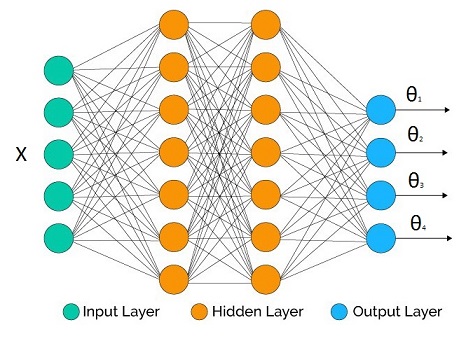Suppose that we are trying to infer the parametric distribution $p(y|\Theta(X))$, where $\Theta(X)$ is a vector output inverse link function with $[\theta_1,\theta_2,...,\theta_M]$.
We have a neural network at hand with some topology we decided. The number of outputs at the output layer matches the number of parameters we would like to infer (it may be less if we don't care about all the parameters, as we will see in the examples below).

In the hidden layers we may use whatever activation function we like. What's crucial are the output activation functions for each parameter as they have to be compatible with the support of the parameters.

Some example correspondence:
- Linear activation: $\mu$, mean of Gaussian distribution
- Logistic activation: $\mu$, mean of Bernoulli distribution
- Softplus activation: $\sigma$, standard deviation of Gaussian distribution, shape parameters of Gamma distribution
Definition of cross entropy:
$$H(p,q) = -E_p[\log q(y)] = -\int p(y) \log q(y) dy$$
where $p$ is ideal truth, and $q$ is our model.
Empirical estimate:
$$H(p,q) \approx -\frac{1}{N}\sum_{i=1}^N \log q(y_i)$$
where $N$ is number of independent data points coming from $p$.
Version for conditional distribution:
$$H(p,q) \approx -\frac{1}{N}\sum_{i=1}^N \log q(y_i|\Theta(X_i))$$
Now suppose that the network output is $\Theta(W,X_i)$ for a given input vector $X_i$ and all network weights $W$, then the training procedure for expected cross entropy is:
$$W_{opt} = \arg \min_W -\frac{1}{N}\sum_{i=1}^N \log q(y_i|\Theta(W,X_i))$$
which is equivalent to Maximum Likelihood Estimation of the network parameters.
Some examples:
$$\mu = \theta_1 : \text{linear activation}$$
$$\sigma = \theta_2: \text{softplus activation*}$$
$$\text{loss} = -\frac{1}{N}\sum_{i=1}^N \log [\frac{1} {\theta_2(W,X_i)\sqrt{2\pi}}e^{-\frac{(y_i-\theta_1(W,X_i))^2}{2\theta_2(W,X_i)^2}}]$$
under homoscedasticity we don't need $\theta_2$ as it doesn't affect the optimization and the expression simplifies to (after we throw away irrelevant constants):
$$\text{loss} = \frac{1}{N}\sum_{i=1}^N (y_i-\theta_1(W,X_i))^2$$
$$\mu = \theta_1 : \text{logistic activation}$$
$$\text{loss} = -\frac{1}{N}\sum_{i=1}^N \log [\theta_1(W,X_i)^{y_i}(1-\theta_1(W,X_i))^{(1-y_i)}]$$
$$= -\frac{1}{N}\sum_{i=1}^N y_i\log [\theta_1(W,X_i)] + (1-y_i)\log [1-\theta_1(W,X_i)]$$
with $y_i \in \{0,1\}$.
- Regression: Gamma response
$$\alpha \text{(shape)} = \theta_1 : \text{softplus activation*}$$
$$\beta \text{(rate)} = \theta_2: \text{softplus activation*}$$
$$\text{loss} = -\frac{1}{N}\sum_{i=1}^N \log [\frac{\theta_2(W,X_i)^{\theta_1(W,X_i)}}{\Gamma(\theta_1(W,X_i))} y_i^{\theta_1(W,X_i)-1}e^{-\theta_2(W,X_i)y_i}]$$
Some constraints cannot be handled directly by plain vanilla neural network toolboxes (but these days they seem to do very advanced tricks). This is one of those cases:
$$\mu_1 = \theta_1 : \text{logistic activation}$$
$$\mu_2 = \theta_2 : \text{logistic activation}$$
...
$$\mu_K = \theta_K : \text{logistic activation}$$
We have a constraint $\sum \theta_i = 1$. So we fix it before we plug them into the distribution:
$$\theta_i' = \frac{\theta_i}{\sum_{j=1}^K \theta_j}$$
$$\text{loss} = -\frac{1}{N}\sum_{i=1}^N \log [\Pi_{j=1}^K\theta_i'(W,X_i)^{y_{i,j}}]$$
Note that $y$ is a vector quantity in this case. Another approach is the Softmax.
*ReLU is unfortunately not a particularly good activation function for $(0,\infty)$ due to two reasons. First of all it has a dead derivative zone on the left quadrant which causes optimization algorithms to get trapped. Secondly at exactly 0 value, many distributions would go singular for the value of the parameter. For this reason it is usually common practice to add a small value $\epsilon$ to assist off-the shelf optimizers and for numerical stability.
As suggested by @Sycorax Softplus activation is a much better replacement as it doesn't have a dead derivative zone.

Summary:
- Plug the network output to the parameters of the distribution and
take the -log then minimize the network weights.
- This is equivalent to Maximum Likelihood Estimation of the
parameters.



